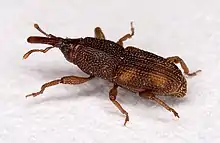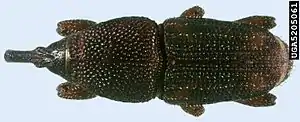| Rice weevil | |
|---|---|
 | |
| Scientific classification | |
| Domain: | Eukaryota |
| Kingdom: | Animalia |
| Phylum: | Arthropoda |
| Class: | Insecta |
| Order: | Coleoptera |
| Infraorder: | Cucujiformia |
| Family: | Curculionidae |
| Subfamily: | Dryophthorinae |
| Tribe: | Litosomini |
| Genus: | Sitophilus |
| Species: | S. oryzae |
| Binomial name | |
| Sitophilus oryzae | |
| Synonyms | |
| |
The rice weevil (Sitophilus oryzae) is a stored product pest which attacks seeds of several crops, including wheat, rice, and maize.
Description
The adults are usually between 3 and 4.6 mm long, with a long snout. The body color appears to be brown/black, but on close examination, four orange/red spots are arranged in a cross on the wing covers. It is easily confused with the similar looking maize weevil. The maize weevil is typically somewhat larger than the rice weevil, but rice weevils as large as the largest maize weevils and maize weevils nearly as small as the smallest rice weevils have been found. Some external features can be used to differentiate the vast majority of adults, but the only reliable features are on the genitalia (see table below). Both species can hybridize. The genitalic structure of hybrids is unknown.[2][3][4][5]
_(3546202126).jpg.webp)
| Rice weevil (S. oryzae) | Maize weevil (S. zeamais) |
|---|---|
 |
.jpg.webp) |
 |
 |
| Longitudinally elliptical punctures on pronotal dorsum | Punctures on pronotal dorsum typically nearly circular, rarely elliptical |
| Pronotal punctures are separated by a flat, median, longitudinal puncture-free zone | Pronotal punctures are nearly equally spaced apart, and pronotum typically has no median puncture-free area (rarely has a narrow puncture-free median zone) |
| Less than 20 pronotal punctures along the approximate midline, running from neck to scutellum | More than 20 pronotal punctures along the approximate midline, running from neck to scutellum (not reliable for individuals not reared on corn, which are typically smaller) |
| Scutellar elevations typically closer together compare to their longitudinal length | Scutellar elevations typically farther apart compared to their longitudinal length |
| Scutellar elevations typically extend longitudinally approximately more than halfway down the scutellum | Scutellar elevations typically extend longitudinally approximately halfway down the scutellum |
| Proepimera meets behind the fore coxae and along the posterior edge, has a distinct notch along the posterior edge at the site of the meeting point | Proepimera meets behind the fore coxae and has a barely discernible notch along the posterior edge at the site of the meeting point |
| Male aedeagus is smooth and shiny on the dorsal surface | Male aedeagus has two dorsal, longitudinal grooves |
| Epipharyngeal rods of larvae have virtually the same width throughout | Epipharyngeal rods of larvae tapering apically |
| Lateral lobes of Y-shaped sclerite of female genitalia not tapering and rounded at apex | Lateral lobes of Y-shaped sclerite of female genitalia tapering and pointed at apex |
| Fewer than five sensory organs at the tip of the labial palps of larvae | More than five sensory organs at the tip of the labial palps of larvae |
Biology

Adult rice weevils are able to fly,[6] and can live for up to two years. Females lay 2–6 eggs per day and up to 300 over their lifetime. The female uses strong mandibles to chew a hole into a grain kernel after which she deposits a single egg within the hole, sealing it with secretions from her ovipositor. The larva develops within the grain, hollowing it out while feeding. It then pupates within the grain kernel and emerges 2–4 days after eclosion.
Male S. oryzae produce an aggregation pheromone called sitophilure ((4S,5R)-5-Hydroxy-4-methylheptan-3-one) to which males and females are drawn. A synthetic version is available which attracts rice weevils, maize weevils and grain weevils. Females produce a pheromone which attracts only males.
Its gammaproteobacterial symbiont Candidatus Sodalis pierantonius str. SOPE is able to supply rice weevil with essential vitamins like pantothenic acid, riboflavin, and biotin.[7] During larvae development, bacteria rely on up-regulation of type three secretion system genes and genes for flagellum so they can infect insect stem cells.[8]
Control
Control of weevils involves locating and removing all potentially infested food sources. Rice weevils in all stages of development can be killed by freezing infested food below −18 °C (0 °F) for a period of three days, or heating to 60 °C (140 °F) for a period of 15 minutes.[9]
See also
- Granary weevil (Sitophilus granarius)
- Maize weevil (Sitophilus zeamais)
References
- ↑ "Sitophilus oryzae". Integrated Taxonomic Information System.
- ↑ Hong KJ, Lee W, Park YJ, Yang JO (2018). "First confirmation of the distribution of rice weevil, Sitophilus oryzae,in South Korea". Journal of Asia-Pacific Biodiversity. 11: 69–75. doi:10.1016/j.japb.2017.12.005.
- ↑ Boudreaux HB (1969). "The Identity of Sitophilus oryzae". Annals of the Entomological Society of America. 62 (1): 169–172. doi:10.1093/aesa/62.1.169.
- ↑ Maceljski M, Korunić Z (1973). "Contribution to the morphology and ecology of the Sitophilus zeamais Motsch. in Yugoslavia". Journal of Stored Product Research. 9 (4): 225–234. doi:10.1016/0022-474X(73)90004-0.
- ↑ "Rice weevil". Padil.gov. 2016-04-03. Archived from the original on 2016-04-03. Retrieved 2017-11-12.
- ↑ Koehler PG (2015-03-18). "Rice Weevil, Sitophilus oryzae (Coleoptera: Curculionidae)". edis.ifas.ufl.edu. Retrieved 2017-11-12.
- ↑ Heddi A, Grenier AM, Khatchadourian C, Charles H, Nardon P (June 1999). "Four intracellular genomes direct weevil biology: nuclear, mitochondrial, principal endosymbiont, and Wolbachia". Proceedings of the National Academy of Sciences of the United States of America. 96 (12): 6814–9. doi:10.1073/pnas.96.12.6814. PMC 21998. PMID 10359795.
- ↑ Maire J, Parisot N, Galvao Ferrarini M, Vallier A, Gillet B, Hughes S, et al. (August 2020). "Spatial and morphological reorganization of endosymbiosis during metamorphosis accommodates adult metabolic requirements in a weevil". Proceedings of the National Academy of Sciences of the United States of America. 117 (32): 19347–19358. doi:10.1073/pnas.2007151117. PMC 7430995. PMID 32723830.
- ↑ "Rice Weevil and Granary Weevil". Iowa Insect Information Notes. 2005-07-29. Retrieved 2013-10-05.